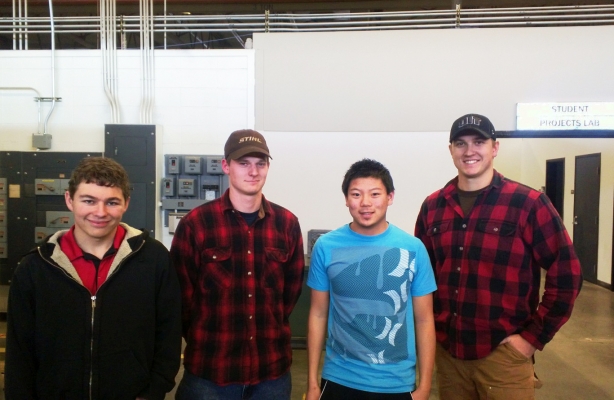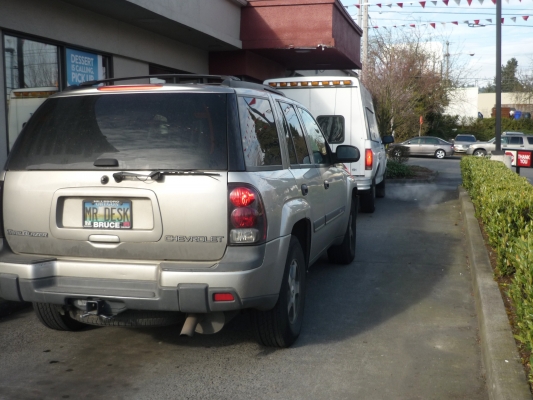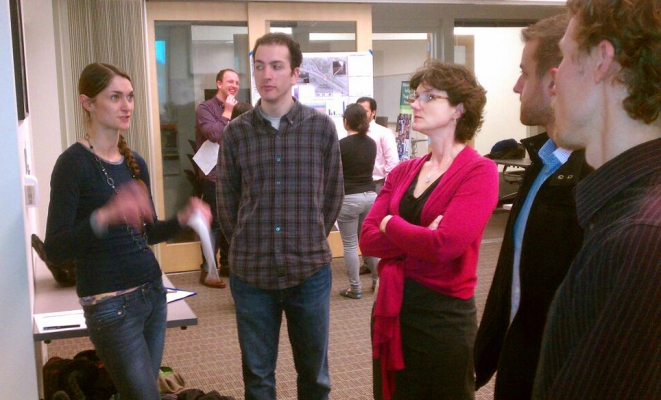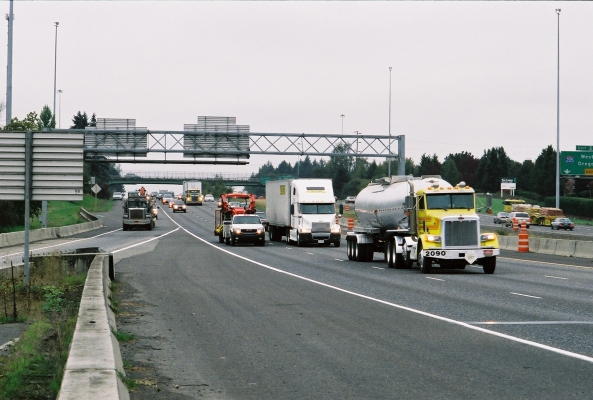During Hurricanes Ivan in 2004 and Katrina in 2005, at least 11 highway and railroad bridges along the U.S. Gulf Coast were damaged. When the water rose during the storms, wave forces slammed into the bridges’ supporting substructures, and when it rose high enough, the water’s buoyancy had enough power to lift off sections of a bridge’s superstructure and lay them aside like giant Legos.
To build bridges that can withstand the force of hurricane waves, engineers must be able to estimate the effects those waves will have on bridge structures. An OTREC project led by Oregon State University professor Daniel Cox examined the effects of wave loading on highway bridge superstructures.
Cox and co-investigator Solomon C. Yim, also of Oregon State University, conducted experiments in the Large Wave Flume at the O.H. Hinsdale Wave Research Laboratory at Oregon State University. They used a 1:5 scale, reinforced concrete model of a section of the Interstate 10 Bridge over Escambia Bay, Fla, which failed during Hurricane Ivan.
To see more details about the project, “Hurricane Wave Forces on Highway Bridge Superstructure,” click here, or download the final report.
The...
Read moreWhen planning their daily commute, most drivers account for the traffic they know is unavoidable: at peak times of day, like morning and afternoon rush hour, they probably allow extra time to get where they’re going.
The delays that are harder to accept are the unexpected ones, when accidents, road work, or a traffic bottleneck turn a thirty minute trip into an hour.
This unpredictable postponement leads to natural frustration on the part of drivers, as it may cause them to be late to work or late picking up children from school. A reliable road network is one in which this is a rare occurrence.
A project led by Portland State University’s Miguel Figliozzi explored the value of this travel-time reliability using a study of commuters’ route choice behavior, taking a look at the trade-offs between reliability, traffic congestion, and air pollution.
The details for the combined project can be found here.
In the first phase of the research, co-investigators David Levinson and Kathleen Harder of the University of Minnesota sought to measure the route choices drivers made in a real-world setting. Instead of just having people fill out a survey about whether they would choose to take major roads or the freeway to work, this study ambitiously...
Read moreGraduate student researcher Alex Bigazzi, of Portland State University, will present his work in Vietnam next week.
The Asia-Pacific Economic Cooperation (APEC) is hosting a transportation workshop in Ho Chi Minh city. The opportunity for Bigazzi to attend is the result of a spontaneous connection he made recently at a conference in Annapolis, Maryland, where he was giving a paper on truck-specific traffic management.
Large trucks contribute a large share of emissions, especially when traveling at a slow crawl through heavy traffic. Bigazzi’s work explores ways to mitigate the effects of this traffic congestion on air quality.
Bigazzi presented two papers at the 54th Annual Transportation Research Forum, which took place March 21-23 in Annapolis. One of them, “The Emissions Benefits of Truck-Only Lane Management,” offers a better understanding of the impacts of congestion on heavy-duty vehicles.
After a question-and-answer exchange, he was invited to present the same research in Vietnam’s largest city.
APEC’s 37th Transportation Working Group Meeting will take place April 8th through the 12th, 2013, at a Sheridan...
Read moreDavid Timm, P.E., the Brasfield & Gorrie Professor of Civil Engineering at Auburn University, traveled to Oregon in mid-March as part of the NITC Visiting Scholar program.
Timm is recognized nationally and internationally as a leading expert in the field of perpetual pavement, a sustainable approach to pavement design. He is also the author of a perpetual pavement design software, PerRoad. Engineers in this field have developed a pavement system that has the potential to last for up to 50 years, with only minor periodic surface repairs.
The visit, arranged by Oregon Tech’s NITC Executive Committee member Roger Lindgren, started with a March 13 PerRoad workshop in Salem. The workshop was attended by designers from industry and from the Oregon Department of Transportation (ODOT).
On March 14, Timm led another PerRoad workshop on the campus of Oregon Institute of Technology in Klamath Falls. Following the workshop was a presentation, focusing on perpetual pavement design and the advancements being made at Auburn’s National Center for Asphalt Technology (NCAT).
The Klamath Falls workshop was attended by 14 engineers and engineering students, with 53 people attending the presentation afterward.
Oregon Tech students boosted their knowledge of sustainable pavement on a conference field trip and brought what they learned back to fellow engineering students on their Klamath Falls campus. Students Jared Jones, Zachary Hudspeth, Michael Eagle and Adam Kershaw attended the Oregon Asphalt Conference in Eugene March 5, sponsored by an OTREC student-support grant. Hudspeth, the ITE Student Chapter president, led the group.
The conference was organized by the Asphalt Pavement Association of Oregon (http://www.apao.org/2013ConfProgram2.htm).
The Oregon Tech students were especially interested in hearing about advances in warm-mix asphalt and RAP (reclaimed asphalt pavement). These two asphalt pavement technologies greatly reduce greenhouse gas emissions compared to traditional asphalt paving.
After returning to campus, the students shared their experiences with students enrolled in Oregon Tech’s Civil Engineering 573 Transportation and Land Development class.
A new OTREC research project, in partnership with the Oregon Department of Transportation, will evaluate the effectiveness of a program to promote "ecodriving," or fuel-efficient driving.
The ODOT program seeks to help the state reduce greenhouse gas emissions by giving commercial drivers training in ecodriving practices.
Led by Portland State University’s Donald Truxillo and John MacArthur, the project was one of the OTREC “Small Starts” grant winners announced earlier this month. The researchers are working with ODOT program manager Stephanie Millar.
ODOT’s effort, rather than concentrating on individual drivers, focuses on entities with a fleet of vehicles at their disposal. Entities — such as the city of Portland, or private, commercial companies — who maintain a fleet of cars and/or trucks will be given materials to educate their employees on ecodriving. It is part of a larger effort on Oregon’s part to reduce harmful emissions and help stop global climate change.
...
Read moreThe Beaverton-Hillsdale Highway, pegged as one of Portland’s high-crash corridors, already attracted the attention of city officials worried about safety. They got more help from Portland State University students during the recently completed term.
Students from civil engineering professor Christopher Monsere’s transportation safety analysis course formed six groups, each studying a piece of the corridor. They presented their findings and recommendations during the course’s open house March 19. The presentation drew officials from local agencies interested in improving corridor safety, including the city of Portland, the TriMet transit agency and the Metro regional government.
The student work dovetails with the city’s own examination of the highway corridor, completed in February. In some cases, as with the Shattuck Road intersection, the students came to many of the same conclusions as city officials, said Wendy Cawley, traffic safety engineer with the Portland Bureau of Transportation. Both found that narrowing the crossing distance could make that intersection safer for pedestrians.
One group looked at the Hillsdale area, recommending a “road diet” approach and other livability-minded changes. While it’s “probably a little more than the city will be able to recommend and handle,” Cawley said, the work has inspired...
Read moreOTREC extends a warm welcome to Research Associate Krista Nordback, Ph.D., P.E., the newest member of the team. She just moved to Portland, Oregon after finishing up her Ph.D. in Denver, Colorado, to continue working on her favorite research focus: urban bicycle safety.
Nordback has been riding bikes since before she was old enough to remember. Together with her husband, Kurt, she continues to enjoy it as a form of both recreation and transportation. When the pair moved to Portland in February of this year, one of their first actions was to bike the Springwater Corridor, the Portland metro area’s 21-mile bike trail, all the way from Portland to Boring on their semi-recumbent tandem.
As a bicycle commuter, safety is one of Nordback’s top priorities, and it’s also the primary goal of her civil engineering research. In her PhD thesis, “Estimating Annual Average Daily Bicyclists and Analyzing Cyclist Safety at Urban Intersections,” she came up with methods for determining the average number of cyclists passing through a given intersection on a daily basis. In order to increase bicycle safety measures in urban areas, one of the first steps is simple yet essential: count the bikes. Having an understanding of the numbers of bicycles that traffic through an area is the starting point for coming up...
Read moreOTREC has announced eight winners of the “Small Starts” grant program, which launched last December. These grants, made available through a new OTREC initiative, were intended to fund small projects related to transportation and community development. Any eligible professor at Portland State University, Oregon State University, the University of Oregon, or the Oregon Institute of Technology was invited to apply for a grant.
Priority was given to tenure-track faculty who are untenured, and faculty who have not received an OTREC grant in the past. The Small Starts program was conceived for the benefit of researchers who want the chance to undertake a small project that supports innovations in sustainable transportation through advanced technology, integration of land use and transportation, and healthy communities.
A total of $60,000 was available to be awarded; with no individual award larger than $10,000.
Interested faculty turned in their proposals by January 31, 2013. Here are the winners:
- Burkan Isgor, Oregon State University:
“Cracking Susceptibility of Concrete Made with Recycled Concrete Aggregates”
- Donald Truxillo, Portland State University, partnered with ODOT:
“Evaluation of ODOT's Ecodriving Program”
- Bob Bass, Portland State University, partnered with Drive Oregon:
“Impacts of Electric Vehicle Charging on Electric Power Distribution Systems “
- Nancy Cheng, University...
Freight transportation is an important part of Oregon’s economy. Helping the statewide freight-transport system run more efficiently means better understanding the movements of trucks on the highways. By monitoring the progress of individual trucks, the Oregon Department of Transportation can obtain valuable performance metrics such as travel time, travel delays, and origin-destination flows. This information can help identify slow passages or bottlenecks in the highway system.
Tracking individual trucks, however, can be problematic. To follow the movements of a truck on the freeway, typical methods might include putting in automatic vehicle identification (AVI) tags, or acquiring a license-plate-recognition system to be used at checkpoints. For ODOT, this could mean purchasing expensive new equipment. Moreover, these tracking methods can raise privacy concerns.
In an OTREC-sponsored research project, Portland State University’s Chris Monsere looked into alternative methods for obtaining those helpful freight metrics without installing tracking units in every single truck. The details of Phase 2 of the project, which expand upon and further refine the results of Phase 1, can be found here. For more information, download the OTREC final report: Exploratory Methods for...
Read more




